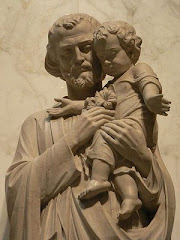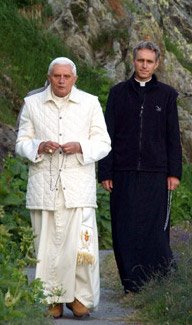Wednesday, April 18, 2012
Memorial of Bl Marie of the Incarnation (Madame Acarie)
"Barbara was born in Paris on Feb. 1, 1566, daughter of Nicholas Avrillot, lord of Champlâtreux, and Mary L'Huillier. Her prime glory is to have contributed more than all others to the introduction of the reform of St. Teresa of Jesus into France, so much so that she merits the title of «mother and foundress of the (Discalced) Carmel in France.» As a young girl she was entrusted to the care of the Little Sisters of the Humility of Our Lady at Longchamp. At the age of fourteen she was recalled to her family. Her parents blocked her aspirations to the religious state; at the age of sixteen she was obliged to marry Peter Acarie, viscount of Villemor, lord of Montbrost and of Roncenay. Beautiful, rich, well-liked, she wished only to correspond with God's graces in the perfect fulfillment of her duties towards her husband, towards her six children, and towards her dependents, whose devoted affection she gained. During the thirty years of her married life she showed how Christian spouses can reach sanctity.
Her faith shone in her unconditional adherence to the Church when the Protestant heresy sought to extend itself to French soil. Meanwhile, she gave herself generously to works of mercy, especially on the occasion of the siege of Paris (1590), and to zeal for the salvation of souls. At the same time she was favored by God with extraordinary graces, which were accompanied, however, by both exterior and interior trials. The period of prosperity was followed by one of misfortune. Her husband was exiled by Henry IV and expelled from Paris after the defeat of the League to which he belonged. In these conditions Barbara learned the meaning of ingratitude; but, upheld by her heroic trust in God, she worked tirelessly day and night for her children and for her husband, until she obtained their complete rehabilitation. When after four years the family was thus reunited and once more in possession of its home and holdings, the blessed again gained popular esteem, including that of the royal family. The young Peter de Bérulle, her cousin and a future cardinal, venerated her as a mother; and St. Francis de Sales gave her his approval and directed her.
In the autumn of 1601 Barbara read the writings of St. Teresa of Avila and felt urged to introduce Teresa's religious reform into France. Trusting in the counsel of theologians and saints and facing up to difficulties of all kinds, in 1602 she began preparing for the foundations of the Teresian Carmel. She gathered the first vocations; she obtained the royal approval and also the pontifical bull of foundation (In supremo, of Pope Clement VIII, Nov. 13, 1603); and she built the first monastery.
Chosen and guided by Peter de Bérulle, six Discalced Carmelite nuns arrived from Spain on Aug. 29, 1604. At their head was the servant of God, Anne of Jesus (Lobera), and as lay sister, Bl. Anne of St. Bartholomew (Garcia). Then, on Oct. 17, the regular life was inaugurated in Paris. Barbara Acarie also cooperated in the new foundations of Pontoise (1605), Dijon (1605) and Amiens (1606), and was happy to see all three of her daughters, beginning with fifteen-year old Margaret, enter there.
Meanwhile Barbara spent herself in continued good works, even though her physical and spiritual sufferings were great. In 1613 her husband fell gravely ill, and she never left his beside until, nine days later, she saw him die the death of the just. The tears and the prayers of the blessed widow were comforted by the heavenly confirmation of the eternal salvation of her pious husband.
Free now from the duties towards her family, Barbara broke every bond with the world and decided to become a Carmelite. Though she was so well-known in Paris, and the various Carmels, which through her efforts were beginning to stud her native land, vied for her presence, she chose Amiens, the poorest and the one farthest away and asked the grace of being received as a lay sister there. On April 7, 1614, she was clothed in the Teresian habit and rapt in ecstasy; she received the name of Mary of the Incarnation.
As a religious, she edified her fervent sisters by her attention to the humblest tasks of the kitchen, by her complete submission to all, by her practice of poverty and a unique finesse in charity, especially towards the sick. Although favored by God with exceptional gifts, she was extremely cautious and preferred the simple practice of the common, solid virtues. She made her solemn profession on April 8, 1615, in the course of a prolonged sickness. The coming of a new prioress from another monastery also caused her much suffering. Then, on Dec. 7, 1616, for reasons of health, she was sent to the Carmel of Pontoise. After a long illness, and after being comforted repeatedly by holy viaticum, by ecstasies and heavenly visions, she died peacefully on April 18, 1618, at Pontoise.
The process for beatification was opened in Rome in 1627. The successive decrees of Pope Urban VIII and other circumstances contributed to have the cause suspended, and it was not resumed until 1782. It was concluded with her beatification, proclaimed by Pope Pius VI on June 5, 1791. Her body lies in the chapel of the convent of Pontoise."
-- Biography by John of Jesus Mary, ocd
-o-
"The great love which you have for me impels me to come to you, all the more because of the existence of the Sacrament of your love, in which you have clearly shown me your love and have drawn me to love you in return; this is why I desire to receive you, so that when my soul is satiated with this spiritual food, I may joyfully embrace you within my soul, never be separated from you and love you with all my heart."
-- Les vraies exercices by Madame Acarie
Her faith shone in her unconditional adherence to the Church when the Protestant heresy sought to extend itself to French soil. Meanwhile, she gave herself generously to works of mercy, especially on the occasion of the siege of Paris (1590), and to zeal for the salvation of souls. At the same time she was favored by God with extraordinary graces, which were accompanied, however, by both exterior and interior trials. The period of prosperity was followed by one of misfortune. Her husband was exiled by Henry IV and expelled from Paris after the defeat of the League to which he belonged. In these conditions Barbara learned the meaning of ingratitude; but, upheld by her heroic trust in God, she worked tirelessly day and night for her children and for her husband, until she obtained their complete rehabilitation. When after four years the family was thus reunited and once more in possession of its home and holdings, the blessed again gained popular esteem, including that of the royal family. The young Peter de Bérulle, her cousin and a future cardinal, venerated her as a mother; and St. Francis de Sales gave her his approval and directed her.
In the autumn of 1601 Barbara read the writings of St. Teresa of Avila and felt urged to introduce Teresa's religious reform into France. Trusting in the counsel of theologians and saints and facing up to difficulties of all kinds, in 1602 she began preparing for the foundations of the Teresian Carmel. She gathered the first vocations; she obtained the royal approval and also the pontifical bull of foundation (In supremo, of Pope Clement VIII, Nov. 13, 1603); and she built the first monastery.
Chosen and guided by Peter de Bérulle, six Discalced Carmelite nuns arrived from Spain on Aug. 29, 1604. At their head was the servant of God, Anne of Jesus (Lobera), and as lay sister, Bl. Anne of St. Bartholomew (Garcia). Then, on Oct. 17, the regular life was inaugurated in Paris. Barbara Acarie also cooperated in the new foundations of Pontoise (1605), Dijon (1605) and Amiens (1606), and was happy to see all three of her daughters, beginning with fifteen-year old Margaret, enter there.
Meanwhile Barbara spent herself in continued good works, even though her physical and spiritual sufferings were great. In 1613 her husband fell gravely ill, and she never left his beside until, nine days later, she saw him die the death of the just. The tears and the prayers of the blessed widow were comforted by the heavenly confirmation of the eternal salvation of her pious husband.
Free now from the duties towards her family, Barbara broke every bond with the world and decided to become a Carmelite. Though she was so well-known in Paris, and the various Carmels, which through her efforts were beginning to stud her native land, vied for her presence, she chose Amiens, the poorest and the one farthest away and asked the grace of being received as a lay sister there. On April 7, 1614, she was clothed in the Teresian habit and rapt in ecstasy; she received the name of Mary of the Incarnation.
As a religious, she edified her fervent sisters by her attention to the humblest tasks of the kitchen, by her complete submission to all, by her practice of poverty and a unique finesse in charity, especially towards the sick. Although favored by God with exceptional gifts, she was extremely cautious and preferred the simple practice of the common, solid virtues. She made her solemn profession on April 8, 1615, in the course of a prolonged sickness. The coming of a new prioress from another monastery also caused her much suffering. Then, on Dec. 7, 1616, for reasons of health, she was sent to the Carmel of Pontoise. After a long illness, and after being comforted repeatedly by holy viaticum, by ecstasies and heavenly visions, she died peacefully on April 18, 1618, at Pontoise.
The process for beatification was opened in Rome in 1627. The successive decrees of Pope Urban VIII and other circumstances contributed to have the cause suspended, and it was not resumed until 1782. It was concluded with her beatification, proclaimed by Pope Pius VI on June 5, 1791. Her body lies in the chapel of the convent of Pontoise."
-- Biography by John of Jesus Mary, ocd
-o-
"The great love which you have for me impels me to come to you, all the more because of the existence of the Sacrament of your love, in which you have clearly shown me your love and have drawn me to love you in return; this is why I desire to receive you, so that when my soul is satiated with this spiritual food, I may joyfully embrace you within my soul, never be separated from you and love you with all my heart."
-- Les vraies exercices by Madame Acarie
Subscribe to:
Posts (Atom)












